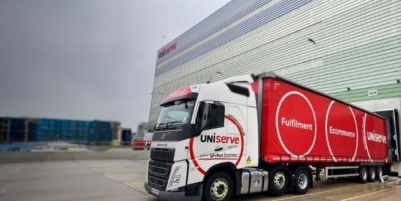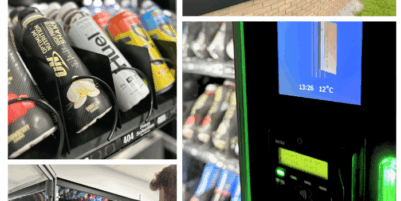-
GOPLASTICPALLETS.COM CELEBRATES MONUMENTAL 2,000 TONNE RECYCLING MILESTONE - 12 hours ago
-
LSA INTERNATIONAL CHOOSES PROLOG FULFILMENT TO MANAGE ITS DISTRIBUTION & LOGISTICS - 1 day ago
-
Uniserve Partners with Logistics Reply to Deliver Transformation to Customers Supply Chains - 1 day ago
-
Nutrivend selects Forterro’s Orderwise to support online expansion and streamline operations - April 11, 2025
-
ARROWXL LAUNCHES AMBITIOUS ZERO WASTE ROADMAP - April 8, 2025
-
THE BCMPA’S NEW CAMPAIGN DRIVES OUTSOURCING SUCCESS IN Q1 - April 7, 2025
-
BLACKOUT TECHNOLOGIES TARGETS TELEMATICS-INTEGRATED MOBILE DEVICE BLOCKING TO COMBAT SMARTPHONE DISTRACTION - April 1, 2025
-
OpenADR Alliance announces first OpenADR 3.0 certified products with EVoke Systems, E.ON Energy and Universal Devices - March 25, 2025
-
Growing fulfilment and contract packer appoints new Managing Director - March 25, 2025
-
When is it time to invest in a WMS? Understanding the key trigger points - March 25, 2025
IRI Inflation analysis calls for FMCG brands and retailers to look beyond the headlines and tap into changing consumer behaviour
Highlights successful growth strategies of inflation-busting brands
Gap between consumer optimism and reality – shoppers react to ‘sticker shock’ rather than marginal price increases
New analysis published today by IRI, a leading provider of big data, predictive analytics and forward-looking insights, calls on FMCG (fast moving consumer goods) retailers and manufacturers to look beyond the current headlines on inflation and adopt a different mindset to tap into rapidly changing consumer behaviour.
Describing the current economic uncertainty as an ‘imperfect inflation’, ‘Beyond the Headlines: A different mindset for a different inflation’ highlights a major convergence of several demand and supply factors, including rising commodity and energy prices and supply chain disruptions. With consumer confidence falling, ongoing fears over Covid, and a widening gap between rich and poor, the industry needs to mitigate inflationary pressures by adopting a new approach, and using the whole marketing toolbox beyond established revenue and price management principles.
“The outlook for this year suggests we are sailing into choppy macroeconomic waters,” comments Ananda Roy, SVP, Strategic Growth Insights, IRI International. This is not the first inflation we have seen and it won’t be the last, but it is very different so we wanted to dig beneath the headlines to find out why.
“Looking at past inflationary events, we begin to understand how sustained inflation can affect consumer choices depending on income and based on price sensitivity and perceived value. In response, manufacturers and retailers have tended to respond by applying well-established revenue management principles. But with people evaluating where they shop, how much and how often they buy and consume, and whether to uptrade, defer a purchase or even to leave a category altogether, brands and retailers need to better understand these changing needs.”
Characteristics of inflation-busting brands
IRI analysed 40 FMCG brands that have successfully mitigated past inflations to reveal the key characteristics – and to show manufacturers how they can be more resilient within their categories:
1. Target consumers with greater precision
High performing brands think of inflation as an opportunity because consumers are actively re-evaluating their consumption habits and relationship with brands. They invest in understanding changing needs and behaviours that are likely to shift demand and offer growth opportunities. They also re-align their marketing portfolio, pricing, distribution, revenue management, and brand mix to ensure they are in the right markets with the right product at the right price.
2. Behave counter-intuitively
They ‘invest in the trough’ by adapting in the short term but staying consistent in the long term. This may include counter-intuitive behaviour like reducing innovations and investing that marketing budget in trade promotions (while phasing innovation for recovery), and partnering with other businesses and rivals on transportation and distribution to cut costs. In addition, they never compromise on the brand promise – quality, trust, ethics and sustainability goals are not replaceable.
3. All brands are equally vulnerable
High performing brands recognise that Premium, Mainstream and Private Label are all equally vulnerable to the effects of inflation and recession. This includes price increases due to unpredictable factors, threat of price wars, consumer up- or down-trading, and lack of availability in the right stores.
Consumer optimism vs. reality
IRI’s analysis includes a survey of 3,000 consumers in 12 countries*, which reveals a gap between optimism and reality. While 91% of respondents expect the price of goods and services to go up – 7% expect prices to go down – more than two-thirds (68%) feel they will be “significantly or somewhat better off” over the next six months.
According to IRI, shoppers are less likely to react to marginal price increases and more likely to react to ‘sticker shock’, such as big price hikes at the forecourt or rising energy bills. This reflects the gap between headline inflation rates and forecasts and actual changes in consumer purchase and consumption behaviour.
IRI’s Ananda Roy adds: “Shoppers in-store may be too embarrassed to return items once they get to the till and discover they have spent too much, but will change their behaviour next time, either buying less, looking for deals, or switching to another retailer. With more of us shopping online, it’s easier to manage spending and make adjustments in order to stay within budget without embarrassment.”
Additional insights from IRI’s Inflation analysis:
- The ‘squeezed middle’ – large manufacturers and private labels are more able to mitigate the effects of inflation. Mid-sized and smaller manufacturers and retailers – the ‘squeezed middle’ – face margin erosion and sales value declines with the added threat of price wars.
- Non-food more resilient than food categories – they have learnt from a challenging pandemic and are more resilient entering into this inflation, optimising their portfolio and range assortment, carrying lower stock levels and reducing innovation. Food categories can learn from this experience.
IRI is running a ‘Beyond the Headlines. An Imperfect Inflation’ webinar on 24 Feb (10.30-11.30am GMT) to uncover why current inflationary trends across some of the world’s largest economies are already having an effect and discuss the approach FMCG category leaders must take to mitigate its impact: https://register.gotowebinar.com/register/3877754730961807116?source=website























